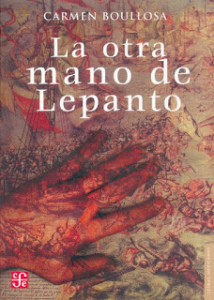 La otra mano de Lepanto – Bazar de hallazgos
La otra mano de Lepanto – Bazar de hallazgos
La otra mano de Lepanto – Grado Cero Prensa
Cervantes y Boullosa: relaciones intertextuales en La otra mano de Lepanto – Dolores Rangel
Review by Milagros Sanchez Arnosi – Cuadernos Hispanamericanos
The presentation of “La otra mano de Lepanto” at the Palacio de Bellas Artes featuring Carmen Boullosa, Juan Villoro, and Jorge Volpi – En Español (Quicktime)
Algunos comentarios expuestos la presentación de “La otra mano de Lepanto” – Sala Manuel M. Ponce de Bellas Artes, en la ciudad de Mexico
Lleva a las letras historia de heroína de Lepanto – La Universal Online
“Cervantes es una iluminación para mi obra” – El País
Carmen Boullosa, escritora: Veo a Cervantes como un ”ilegal” – La Razón
Abuelita chocolate – Barbara Jacobs, La Journada
Original novela sobre el choque de civilizaciones – Mundo (PDF)
 Recomendación del mes de www.siruela.com
Recomendación del mes de www.siruela.com
Las mejores 100 novelas de la lengua española de los últimos 25 años – Semana
El autor en La otra mano de Lepanto:
I first encountered the woman who is the basis for my novel’s principal character – María la Bailaora, a sword master and pre-flamenco dancer — in a history of the Battle of Lepanto, the epic sixteenth century clash between Christians and “Turks”. The historical María, dressed as a male soldier, was reported to have dispatched forty Turcos with her sword during a bloody fight aboard the Royal Galley.
My novel imagines her life: her childhood growing up as a gypsy in Granada; her placement in a convent after her father is sent to the galleys; her attachment to the “Moriscos” (the Moors) who, like the gypsies, are being expelled from Spain; her Mediterrane voyage on a secret mission, in the course of which she is captured by Algerian pirates; her eventual arrival in Naples where she falls in love with a “caballero” and enrolls as a soldier in the Christian army. The culmination of the novel is a reconstruction of the Battle of Lepanto, as narrated by a “pícaro,” a young man who loves to gamble and drink but has been forced by his father to join the navy and become an honorable man. He observes and describes the Christian victory with cynical eyes and mocking pen. The book recounts Maria’s meeting Cervantes, himself a participant in the battle, and concludes with her subsequent murder.
Beyond telling the story of Maria’s life, loves, and battles, the novel explores the larger world of Cervantes, the social and historical universe within which “El Quixote” was conceived. It’s a moment of national ethnic “cleansing” – perhaps the first of the modern era – when Spain expels its Moors; and of a titanic clash of civilizations, pitting Catholic Europe against the Ottoman Empire. Not only is the novel grounded in this historical epoch, but most of its characters, and some of its subsidiary dramas, are borrowed from Cervantes’ novels and plays (or those of his literary contemporaries), or adopted from his life.
The language, too, is steeped in Cervantes’ time – a bit baroque, very powerful, very literary. The early pages, those which set the stage and establish the tone, are stately and ornamented. Then the text gains velocity, and after page 85 its starts running and doesn’t stop till its breathless conclusion.
The author on La otra mano de Lepanto:
I first encountered the woman who is the basis for my novel’s principal
character – María la Bailaora, a sword master and pre-flamenco dancer
— in a history of the Battle of Lepanto, the epic sixteenth century clash between
Christians and “Turks”. The historical María, dressed as a male soldier,
was reported to have dispatched forty Turcos with her sword during a bloody fight
aboard the Royal Galley.
My novel imagines her life: her childhood growing
up as a gypsy in Granada; her placement in a convent after her father is sent
to the galleys; her attachment to the “Moriscos” (the Moors) who,
like the gypsies, are being expelled from Spain; her Mediterrane voyage on a secret
mission, in the course of which she is captured by Algerian pirates; her eventual
arrival in Naples where she falls in love with a “caballero” and enrolls
as a soldier in the Christian army. The culmination of the novel is a reconstruction
of the Battle of Lepanto, as narrated by a “pícaro,” a young
man who loves to gamble and drink but has been forced by his father to join the
navy and become an honorable man. He observes and describes the Christian victory
with cynical eyes and mocking pen. The book recounts Maria’s meeting Cervantes,
himself a participant in the battle, and concludes with her subsequent murder.
Beyond
telling the story of Maria’s life, loves, and battles, the novel explores the larger world of Cervantes, the social and historical universe within which
“El Quixote” was conceived. It’s a moment of national ethnic
“cleansing” – perhaps the first of the modern era – when
Spain expels its Moors; and of a titanic clash of civilizations, pitting Catholic
Europe against the Ottoman Empire. Not only is the novel grounded in this historical
epoch, but most of its characters, and some of its subsidiary dramas, are borrowed
from Cervantes’ novels and plays (or those of his literary contemporaries),
or adopted from his life.
The language, too, is steeped in Cervantes’
time – a bit baroque, very powerful, very literary. The early pages, those
which set the stage and establish the tone, are stately and ornamented. Then the
text gains velocity, and after page 85 its starts running and doesn’t stop
till its breathless conclusion.
